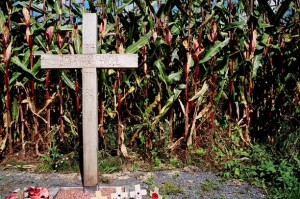
A marker at one point along the Western Front commemorating the unofficial 1914 Christmas truce.
I walk down in the darkness of the morning towards our Fahoo Foray tree, its splendid multi-coloured lights spiraling upwards towards the sky and into the stars. Is it the same sky that a soldier watched so many distant years ago as Christmas 1914 came upon the trenches? On that day did the cannon and guns curb their enthusiasm for war; were they strong at first, muffled and then mute?
From those trenches during that first year of carnage, softened choruses rose above the parapet and carried themselves across the short gap called no man’s land. “Stille Nacht, Heilige Nacht”, and the pledge of men in uniform waiting, wondering, thinking of home, allowed all men to turn their thoughts, for however brief, of friends and family, home for the holidays. The Great War, many had felt, would be over by Christmas, many joined in order to be involved before it was all over.
On that night the spirits of the Past, Present and Future brought together men from opposing sides onto the tumult of the earth. As they climbed the parapets and met each other face to face, as one man to another, and not from the end of a rifle or bayonet they exchanged gifts, souvenirs and spoke in languages perhaps not known to one another. Tommy and Fritz shared a distant peace on that night for at least a small part of this war that continued to endure until November 1918.
As the silent night turned to light and into another day, the sounds of war began their erstwhile chorus and so too into the darkness the glow of star shells filled the sky with light.
Tags: 1914, Christmas Truce, The Western Front
This entry was posted by pferguson
on Saturday, December 24th, 2011 at 5:47 pm and is filed under Christmas Special.
You can follow any responses to this entry through the RSS 2.0 feed.
You can leave a response, or trackback from your own site.
About The Author

Paul has worked with the Paradigm Motion Picture Company since 2009 as producer, historian and research specialist. Paul first met Casey and Ian WIlliams of Paradigm in April 2007 at Ieper (Ypres), Belgium when ceremonies were being held for the re-dedication of the Vimy Memorial, France.
Paul's sensitivity to film was developed at an early age seeing his first films at RCAF Zweibrucken, Germany and Sardinia. Paul returned to Canada in 1967 and was captivated by David Lean's "Lawrence of Arabia" and "Bridge on the River Kwai". Over time Paul became increasingly interested in storytelling, content development, character, direction, cinematography, narration and soundtracks.
At the University of Victoria, Paul studied and compared Japanese and Australian film and became interested in Australian film maker Peter Weir and his film "Gallipoli" (1981). Paul was inspired when he learned Weir visited the beaches, ridges and ravines of the peninsula. "Gallipoli", the film, led Paul on many journeys to sites of conflict in England, France, Belgium, Holland, Germany, Malta, Hawaii, Gallipoli, North Macedonia and Salonika.
When Paul first watched documentary filmmaker Ken Burns, "The Civil War", Paul understood how his own experience and insight could be effective and perhaps influential in film-making. Combining his knowledge of Museums and Archives, exhibitions and idea strategies with his film interests was a natural progression.
Paul thinks like a film-maker. His passion for history and storytelling brings to Paradigm an eye (and ear) to the keen and sensitive interests of; content development, the understanding of successful and relational use of collections, imagery and voice. Like Paul's favorite actor, Peter O'Toole, Paul believes in the adage “To deepen not broaden.”
While on this path Paul always remembers his grandmother whose father did not return from the Great War and how his loss shaped her life and how her experience continues to guide him.


Comments